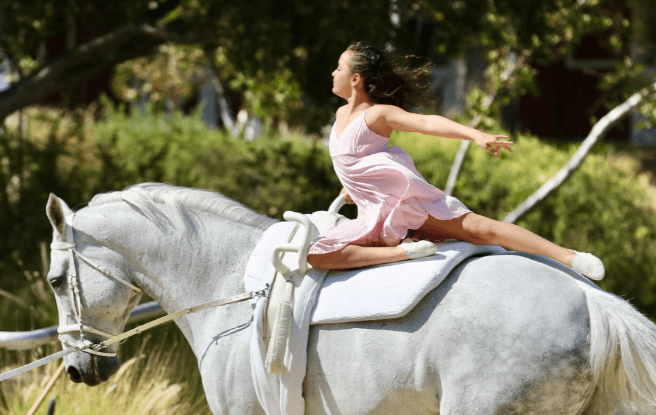How can one train a horse for equestrian vaulting?

Equestrian vaulting is not just a sport but a profound demonstration of harmony between a horse and vaulter. It requires the horse to maintain a steady canter in a circle while the vaulter performs gymnastic feats on its back. This discipline not only showcases the vaulter’s skills but also the horse’s training and temperament.
The Ideal Vaulting Horse: Traits and Characteristics
The perfect vaulting horse is calm, balanced, and symmetrically built, with a steady, rhythmic canter that provides a reliable platform for the vaulter. They should also possess a good temperament to handle the dynamic nature of vaulting routines.
Starting with the Basics: Conditioning Your Horse
Before introducing your horse to vaulting, begin with basic conditioning. This includes regular exercise routines that build muscle and endurance, preparing them for the physical demands of carrying a vaulter.
Developing Trust and Bonding
Trust and bonding are critical in vaulting. Spend time with your horse through grooming and ground exercises to build a connection that will translate into better performance in the ring.
Training for the Canter: The Preferred Gait for Vaulting
The canter is essential in vaulting. Train your horse to achieve a smooth, consistent canter that can be easily maintained on a lunge line. This gait should be comfortable for both horse and vaulter, providing the necessary rhythm and balance.
Desensitization Techniques
Desensitization helps your horse get used to unusual situations and movements. Use techniques like exposing your horse to the vaulting barrel, pads, and even the weight of different vaulters in controlled environments.
Introduction to Equipment
Familiarize your horse with all the vaulting equipment, including the surcingle and bridle. Allow them to feel comfortable with these on both in static environments and while moving.
The Lunge Line Basics
The lunger plays a crucial role in equestrian vaulting. Train your horse to respond to commands from the lunger, who will guide them from the center of the circle, ensuring the horse moves correctly and safely.
Training Commands and Cues
Develop a set of commands and cues that your horse understands. This includes verbal cues and slight adjustments in body weight and position, which will help direct the horse during routines.
Progressive Loading: Introducing Weight and Movement
Start by introducing weight slowly on your horse’s back. Begin with simple standing exercises on a vaulting barrel before transitioning to the horse. Gradually increase the complexity of the movements as your horse becomes more comfortable.
Safety Measures and Protective Gear
Always prioritize safety by using appropriate protective gear for both the horse and vaulter. Ensure that the training area is safe and enclosed, with soft footing to prevent injuries.
Regular Health Check-Ups and Maintenance
Regular veterinary check-ups ensure that your horse remains in top health, capable of performing without risk of injury. Maintenance includes regular hoof care, dental checks, and monitoring for any signs of discomfort or distress.
Advanced Training Techniques
As your horse becomes more adept at basic vaulting tasks, introduce more complex maneuvers. This can include higher jumps, different styles of mounts and dismounts, and increasing the pace of routines.
Psychological Training for Your Horse
Understanding and addressing the psychological needs of your horse is crucial. They should be confident and not feel overburdened by the tasks. Techniques such as positive reinforcement can be very effective.
Troubleshooting Common Issues in Vaulting Horses
Be aware of common issues such as reluctance to canter, difficulty maintaining rhythm, or discomfort with equipment. Address these promptly with adjustments to training or equipment.
Preparing for Competition
Prepare your horse for competition by simulating competitive environments during training sessions. This includes exposure to crowds, sounds, and different arenas.
The Role of the Lunger
The lunger must be skilled in handling the horse, providing directions, and maintaining the correct speed and circle size during routines. Their role is critical in both training and competitive settings.
Nutrition and Diet for a Vaulting Horse
A balanced diet is essential for keeping your horse in peak condition. Consult with a nutritionist to ensure your horse’s diet supports their energy needs and health.
Rest and Recovery
Rest and recovery are as important as the training itself. Ensure your horse has enough downtime and a comfortable environment to recuperate from the physical demands of vaulting.
Engaging a Professional Trainer
Consider working with a professional vaulting trainer who can provide specialized knowledge and experience in training both horses and vaulters.
Case Studies: Success Stories of Trained Vaulting Horses
Explore real-life success stories of horses that have been trained in equestrian vaulting. These can provide valuable insights and inspiration.
Future Prospects in Equestrian Vaulting
Discuss the growth of equestrian vaulting as a sport and its benefits for both horses and riders, highlighting how training in this field can open new opportunities.
Glossary of Terms in Equestrian Vaulting
A detailed glossary of terms provides deeper understanding of the technical language used in equestrian vaulting.
Conclusion
Training a horse for equestrian vaulting is a rewarding journey that enhances the bond between horse and human, fostering a mutual respect and understanding that is vividly displayed in the arena. By following the outlined steps and dedicating time to each phase of training, you can prepare your horse to excel in this spectacular sport.







